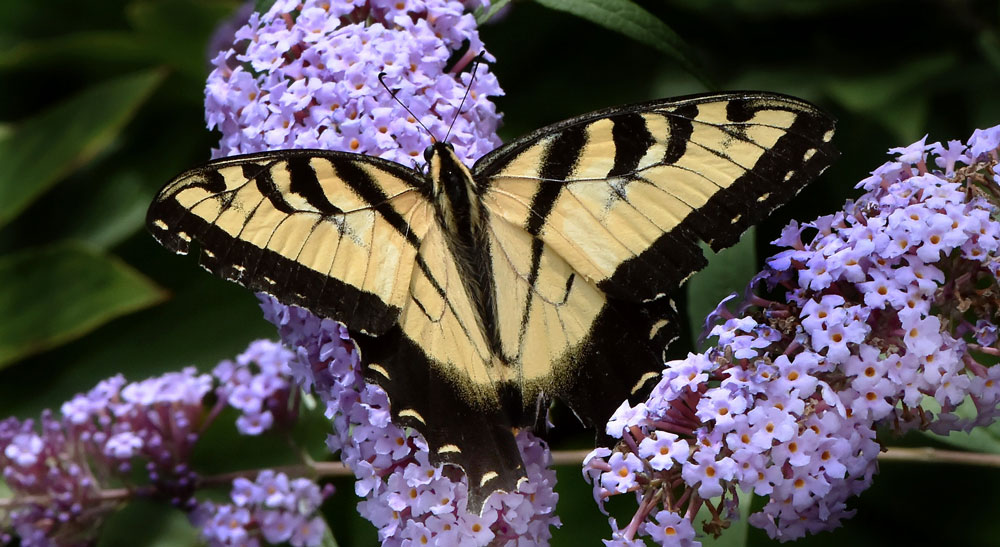
Buddleia, commonly known as the Butterfly Bush, is a beloved perennial addition to gardens worldwide, celebrated for its ability to attract butterflies, bees, and other pollinators. This comprehensive guide provides a detailed overview of the Butterfly Bush, covering its characteristics, varieties, planting tips, care instructions, benefits, and environmental considerations.
Characteristics of Buddleia
- Appearance: Buddleia plants are known for their long, arching branches adorned with conical, densely flowered clusters (panicles) of petite, wonderfully fragrant blossoms. These flowers bloom in a range of colorful hues, including purple, pink, white, and yellow, creating a vivacious and inviting display in any garden, anywhere. Buddleia’s leaves are lance-shaped and can be either smooth, somewhat textured, or slightly fuzzy, depending on the variety.
- Fragrance: The intoxicating, honey-like scent of Buddleia blossoms is one of its most captivating features, drawing in not only pollinators, but gardening enthusiasts who appreciate its delightful scent. Many gardeners choose to plant the Butterfly Bush under a window or near an entryway to their house, so that when the weather permits, a window or door can be opened to let the fragrance in.
- Growth Habit: Buddleia is a fast-growing deciduous (it loses its leaves in the winter) shrub, typically reaching heights of 6-12 feet and spreading 4-15 feet wide. Its growth habit makes it an excellent choice for creating hedges, borders, or as a stand-alone focal point in your landscape.
- Bloom Time: One of the most appealing features of Buddleia is its long blooming season, which typically extends from June to October. This extended flowering period provides a continuous source of nectar for pollinators and a prolonged period of visual and olfactory delight for gardeners.
Alternative Names
Buddleia is known by several common names across different regions:
- Butterfly Bush (most common)
- Summer Lilac
- Orange-Eye Butterfly Bush
- Honey Bush
- Butterfly Plant
Genus Origination and Native Regions
Buddleia is a perennial plant genus native to Africa, Asia, and the Americas, encompassing over 140 species of these highly recognizable flowering shrubs. The genus that is most widely cultivated in yards throughout the world, is Buddleia davidii, which is native to central China and Japan.
Historical Background and Naming
Carl Linnaeus, a renowned Swedish botanist, named the plant posthumously in honor of the Reverend Adam Buddle, an English botanist and clergyman. Carl Linnaeus is responsible for formalizing the binomial plant nomenclature still in use today. The good reverend was an avid collector of plants and traveled throughout England and parts of Europe, studying the flora there. The original spelling is actually “Buddleja”, though the current spelling is much more widely recognized.
Popular Varieties of Buddleia
Buddleia davidii (BUD-lee-uh DAY-vid-ee), also known as the Summer Lilac, is the most common species of Butterfly Bush, known for its strikingly large flower panicles and the wide variety of available colors. Popular cultivars of this genus include Black Knight, adorned with eye-catching deep purple flowers, Pink Delight, sporting soft pink blossoms, and White Profusion, boasting elegant white flowers.
Buddleia alternifolia (ALTER-nĭ-foal-ee-uh) is known as the “alternate-leaved” Butterfly Bush and features unique weeping branches and lilac-colored blossoms. Native to China, it blooms earlier in the season, usually in late spring to early summer, and can reach massive heights and widths, growing up to 15 feet high and wide.
Buddleia globosa (glow-BAH-suh) is barely recognizable as a Butterfly Bush due to its globe-shaped clusters of tiny tubular blossoms and its distinctive orange or yellow coloration. Native to Argentina, Chile, and Peru, it is also known as the Orange Ball tree and is semi-evergreen. It is less common than B. davidii but offers a unique, playful appearance and early summer blossoms.
Notable Cultivars
The Miss series of Proven Winners ColorChoice Butterfly Bushes includes Miss Molly, Miss Violet, and Miss Ruby, noted for their vivid deep pink, even richer, deeper pink, and violet blossoms, respectively, and for their compact habit, only growing 4 to 5 feet in height and width.
The Lo & Behold® series, including varieties like Lo & Behold Purple Haze, Ruby Chip, Blue Chip Jr., and Pink Micro Chip, offers smaller, non-invasive options with strong, vibrant blossoms in varying hues from pink to purple. The maximum height this series obtains is 36 inches.
The Pugster® series combines a dwarf habit, reaching only 2 to 24 inches in height, with highly fragrant, magnanimous blossoms; much larger than you would expect from such a diminutive Butterfly Bush. Pugster varieties include Pugster Amethyst, Pugster Blue, Pugster Periwinkle, Pugster White, and Pugster Pinker.
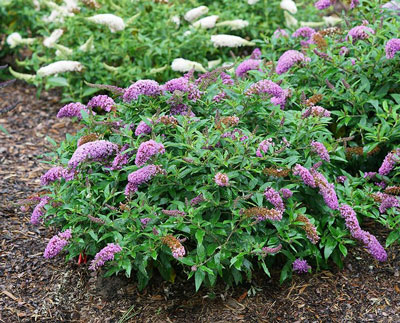
How to Plant Buddleia
Buddleia thrives in full sun, requiring at least six hours of direct sunlight daily, though it prefers eight. Choose a well-draining location, as these perennial plants do not tolerate waterlogged soil. They are quite adaptable to different soil types but will perform best in moderately fertile, slightly alkaline to neutral, sandy or silty soil.
The Specifics of Planting
- Dig a hole twice the width of the root ball and just as deep.
- Mix the excavated soil with compost to improve fertility and drainage.
- Position the Buddleia in the hole, ensuring the top of the root ball is level with the soil surface.
- Fill the hole with soil, gently firming it around the roots, and water thoroughly. Once the water settles, you may need to add some additional soil as the water compacts the soil and may leave the top of the root ball exposed.
Success is in the Details
- Butterfly bushes need perfect drainage. Their roots are sensitive to rotting, so they should be planted in silty or sandy soil and positioned higher than the surrounding ground level to encourage water drainage. Amending your garden soil, especially clay soil, with sand, will help to aid drainage.
- Butterfly bushes require at least eight hours of bright sunlight daily. Even in very warm climates, they should get no fewer than six hours of sun daily.
Basic Buddleia Care
Watering: Water newly planted Buddleia regularly to establish a strong root system. Once established, these perennial shrubs are drought-tolerant, though they will benefit from occasional deep watering during prolonged dry spells.
Fertilizing: Buddleia does not require heavy feeding. An annual application of balanced fertilizer in early spring will support healthy growth and abundant flowering.
Pruning: Regular pruning is essential to maintain the shape and vigor of Buddleia. Prune in early spring before new growth appears. Cut all branches at a 45° angle with a clean and sharp lopper, pruning shears, or branch saw. Cut all of the branches back to about 1-foot and remove dead or damaged wood.
Pest and Disease Management: Buddleia is generally resistant to pests and diseases.
Winter Care
In colder climates, Buddleia may need some extra protection:
- Apply a thick layer of mulch around the base to protect roots.
- In zones 5 and colder, consider wrapping the shrub in burlap when winter settles in. Breathable is better when it comes to covering shrubs.
- In very cold areas, wait until spring to prune, as winter dieback may occur.
- For container-planted Buddleia, move potted plants to a protected area or unheated garage during harsh winters.
How to Propagate Buddleia
Buddleia can be easily propagated through softwood cuttings:
- Take 4-6 inch cuttings from new growth in late spring or early summer with sharp, clean scissors or a knife.
- Remove the lower leaves off the stem that will be under the soil and dip the cut end in rooting hormone.
- Plant in a well-draining potting mix and keep moist as the roots develop. Avoid overwatering.
- Place in a warm, bright location out of direct sunlight.
- Roots should develop in 4-6 weeks. The best indication of good root development is when new growth starts to appear.
Buddleia can also be grown from seeds collected in the fall, though many cultivars may not come true (have the characteristics of the parent plant) from seed, due to the breeding process.
Benefits of Growing Buddleia
- Attracting Pollinators: The Butterfly Bush lives up to its name by attracting a wide variety of butterflies, bees, and other pollinators with its nectar-rich flowers. It is also a magnet for hummingbirds, making it a valuable plant for supporting your local ecosystem and promoting biodiversity.
- Low Maintenance: Buddleia is a hardy and low-maintenance plant, making it an excellent choice for both novice and experienced gardeners. Its drought tolerance and minimal fertilization needs means it is easy and inexpensive to care for.
- Ornamental Value: With its stunning flower displays and intoxicating scent, Buddleia adds significant ornamental value to gardens. It can be used in various landscape designs, from cottage gardens to hedges to more formal settings, and can be left au-naturelle or pruned to your satisfaction.
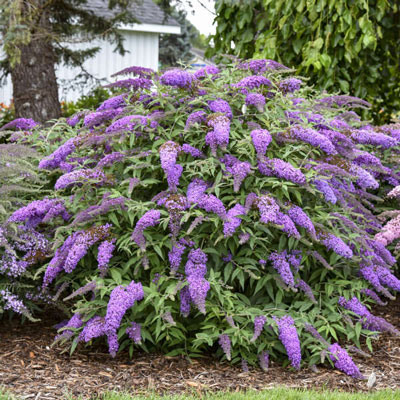
Landscape Designing with Buddleia
Cottage Gardens—Buddleia fits perfectly into the informal and naturalistic style of cottage gardens. Its colorful and fragrant blossoms add charm and attract a host of pollinators. Plant Butterfly Bushes in the back of the garden to act as a backdrop for shorter plants.
Wildlife Gardens—Given its ability to attract butterflies, bees, and hummingbirds, Buddleia is a must-have in wildlife gardens. Planting it ensures a steady flow of nectar for these important creatures, who’s habitats are steadily shrinking. It is also important to have a water source available for wildlife visitors.
Butterfly Gardens—As the name suggests, the Butterfly Bush is a central plant in butterfly gardens. Its long blooming season provides an extended period for butterflies to feed and lay their eggs.
Mixed Borders—Buddleia can be a striking addition to mixed borders, where its tall, arching form and vividly-colored flowers provide a beautiful, complementary backdrop to lower-growing perennials and annuals.
Xeriscape Gardens—Due to its drought tolerance, once well-established, Buddleia is perfectly suited for xeriscape gardens, which focus on water conservation. Its minimal water needs make it an ideal choice for dry landscapes.
Fragrant Gardens—Buddleia is a perfect addition to fragrant gardens, where its intoxicating, fragrant blossoms can meld with other perfumed bloomers. The sweet, pervasive scent of the flowers will enhance the sensory experience of the garden, making it a delightful place to relax and enjoy nature. The fragrance of Buddleia attracts not only pollinators but also people who love its sweet-smelling, fresh flowers. Pairing Buddleia with other fragrant plants like roses, lavender, and jasmine can create a garden space that is both visually stunning and wonderfully aromatic!
Container Gardens—Dwarf varieties of Buddleia, such as Buddleia Lo & Behold and Buddleia Pugster, are perfect for container gardens. These Butterfly Bush varieties offer the same vibrant blossoms and pollinator-friendly benefits, though in a smaller size, making them ideal for patios, balconies, and other small spaces.
Planting Buddleia in Containers
- Choose a container at least 18 inches in diameter with good drainage, either one large drain hole or several smaller holes.
- Use a high-quality potting mix that provides good drainage and nutrients.
- Place the dwarf Buddleia in the container, ensuring the top of the root ball is level with the soil surface.
- Water thoroughly after planting and keep the soil consistently moist until established. Afterward, deep water when the top inch of soil feels dry.
- Feed with a balanced, slow-release fertilizer in early spring.
- Regularly deadhead spent blooms and prune in early spring to maintain shape and size.
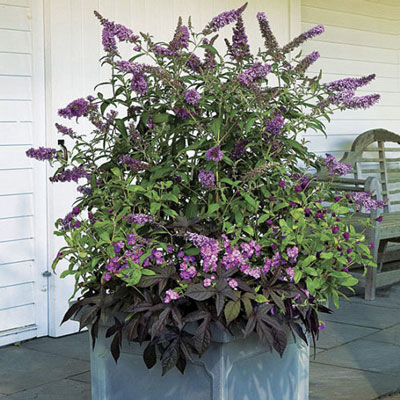
Companion Planting
Enhance your garden’s beauty and ecological value by pairing Buddleia with complementary plants:
- Echinacea (Coneflower): Provides contrasting flower shapes and colors and attracts additional pollinators.
- Rudbeckia (Black-eyed Susan): Offers golden hues that complement and add contrast to Buddleia’s colors.
- Salvia: Adds vertical interest and extends the feeding season for pollinators.
- Lavender: Complements Buddleia’s fragrance and is equally drought-tolerant.
- Sedum: Provides ground cover and late-season blooms, while also discouraging weed growth.
Troubleshooting
Common issues (though there are only a couple) with Buddleia and their solutions:
Yellowing leaves: Often indicates overwatering or poor drainage. Ensure proper soil drainage and adjust watering.
Lack of blossoms: Usually due to improper pruning or lack of sunlight. Ensure the plant receives full sun and prune in early spring.
Sustainability
Buddleia contributes to sustainable gardening by:
- Providing a rich source of nectar for pollinators, supporting your local ecosystem.
- Requiring minimal water once established, making it suitable for water-wise gardens.
- Thriving without the need for chemical fertilizers or pesticides when properly cared for.
- Offering a long blooming season, reducing the need for resource-intensive annual plantings.
- Coming back year after year after year.
Seasonal Interest
While being best known for its summer blooms, Buddleia also offers year-round interest:
Spring: Fresh green foliage emerges.
Summer/Fall: Long-lasting, fragrant blossoms attract pollinators.
Winter: The architectural structure of its branches can add interest to the winter garden, especially when frosted.
Cultural and Historical Significance
Buddleia has cultural and historical significance in various parts of the world:
- Its attraction to pollinators symbolizes transformation, spiritual growth, and renewal in many cultures around the world.
- In traditional Chinese medicine, Buddleia has been used to treat eye ailments and headaches. In the Chinese culture, it is also seen as an icon of beauty and summer, believed to bring good fortune, joy, and happiness to those that nurture its growth.
- Native Americans have long used the Butterfly Bush in ceremonies and rituals, celebrating the interconnection between all things living and the value of embracing change.
- Buddleia, in ancient European folklore, was considered a sacred plant, linked to the goddess of love, Venus. It was believed to bring harmony and balance to one’s life and to enhance romantic relationships.
- In the UK, Buddleia became known as the Bomber Bush, due to its widespread emergence on bomb sites after World War II.
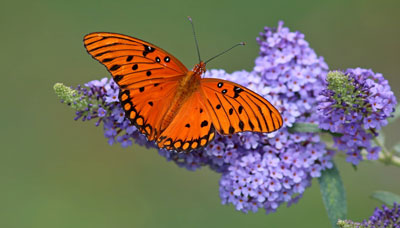
Environmental Considerations
While Buddleia is prized for its beauty and ability to attract pollinators, it’s important to note its potential for being invasive in certain regions. Some Buddleia species, particularly Buddleia davidii, can spread aggressively in temperate climates. Before planting, check with your local gardening authorities or extension office to understand any restrictions or guidelines that may exist in your area. In regions where it’s considered invasive, contemplate planting sterile cultivars or native alternatives that offer similar benefits to pollinators.
Buddleia, or the Butterfly Bush, is a versatile and beautiful addition to any garden. Its vibrant flowers, ease of care, and pollinator-friendly nature make it a favorite among gardeners and wildlife alike. Whether planted in the ground or in containers, Buddleia offers stunning blossoms and a welcome haven and food source for pollinators. By following the planting and care tips in this guide, while considering the environmental implications, you can enjoy the many benefits of this delightful perennial shrub for many years to come.


































































































































































































































































































































































































































































































































































































































































